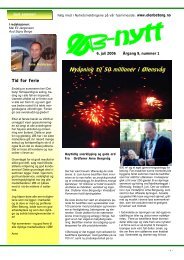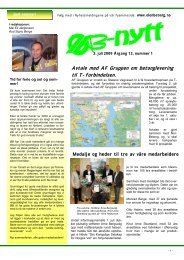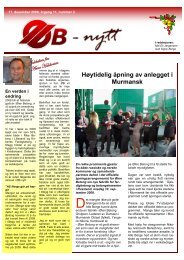English 2012 - Ølen Betong AS
English 2012 - Ølen Betong AS
English 2012 - Ølen Betong AS
You also want an ePaper? Increase the reach of your titles
YUMPU automatically turns print PDFs into web optimized ePapers that Google loves.
The QA Systems<br />
General Description<br />
The basic objectives of <strong>Ølen</strong> <strong>Betong</strong> <strong>AS</strong> in preparing the QA systems have been to build a system<br />
according to existing routines, to incorporate new or better routines where these have been required,<br />
while at the same time not amassing unmanageable quantities of paper.<br />
A fundamental requirement is that the amount of documentation resulting from the QA systems is to be<br />
used constructively such that experiences and results are brought to light and learnt from.<br />
Furthermore, a significant part of the objectives is drafted such that reports derived from the quantities of<br />
documents are to be related to what has been attained previously, and these can be used to achieve the<br />
best possible operational routines.<br />
It is also a firm fundamental idea that the QA system is designed in a way that it, in sum, will provide the<br />
various companies with enhanced safety, better solutions, and increased earning power, all in such a<br />
way that it will not be a negative factor in terms of competitiveness.<br />
We maintain that the establishment of the QA system is primarily intended to initiate and further improve<br />
solid solutions, enhanced quality, and increased productivity for ourselves while at the same time<br />
providing our customers and the authorities with the same experience.<br />
<strong>Ølen</strong> <strong>Betong</strong> QA Systems comprises five elements: Principle drawing of the QA System:<br />
1. The Corporate Quality Manual<br />
2. The Quality Assurance Manual<br />
3. The Compilation of Procedures<br />
4. The Staff Handbook<br />
5. HES-Handbook – IC (Internal Control) - Environment<br />
This includes Environmental Management,<br />
Access Control and ISPS (Port Facility Security)<br />
Unabridged manuals and compilations of procedures have a limited<br />
circulation, but all documents are available to our departments /<br />
divisions as files on our data network. Nevertheless, the Executive<br />
Manager at each plant / department is responsible for briefing and<br />
implementation of the systems for all of the employees in each<br />
company. This includes unambiguous relations concerning the<br />
organisation, easily traceable distribution of responsibility and<br />
authority, and the development and maintenance of all tasks related<br />
to planning, procedures, and supervision.<br />
Environment Management System (EMS)<br />
The company <strong>Ølen</strong> <strong>Betong</strong> <strong>AS</strong> implemented in <strong>2012</strong> an Environmental Management System certified in<br />
accordance with NS-EN ISO 14001. We refer to further information on page 14. In the QA System EMS<br />
is placed under the fifth element: HES-Handbook – IC (Internal Control) - Environment<br />
Port Security - ISPS<br />
Some of the ports owned by the <strong>Ølen</strong> <strong>Betong</strong> Group, are obliged to international ISPS (Security)<br />
requirements. In <strong>2012</strong> this applies to the port facilities in <strong>Ølen</strong>svåg and Mølstrevåg. Documentation<br />
regarding ISPS requirements are placed in separated manuals, kept from public access.<br />
In the QA System ISPS is placed under the fifth element: HES-Handbook – IC (Internal Control) –<br />
Environment, but all documentation is classified, and only accessible for cleared personnel.<br />
1<br />
2 3 4 5<br />
Project QA Plan<br />
Side - 11 -





